See the note at the end if you want to know more about birds …
Several times over the last couple of years I have had non-birder acquaintances ask me about the “bird with polka dots,” “a bird on my lawn with polka dots,” or “the polka dot bird.” In Golden Wings, an anthology of birding tales by Pete Dunne, one of his stories is called “A Flicker Day for Sure” and he captures what happens to birders all over on the autumn days when the polka dot birds move: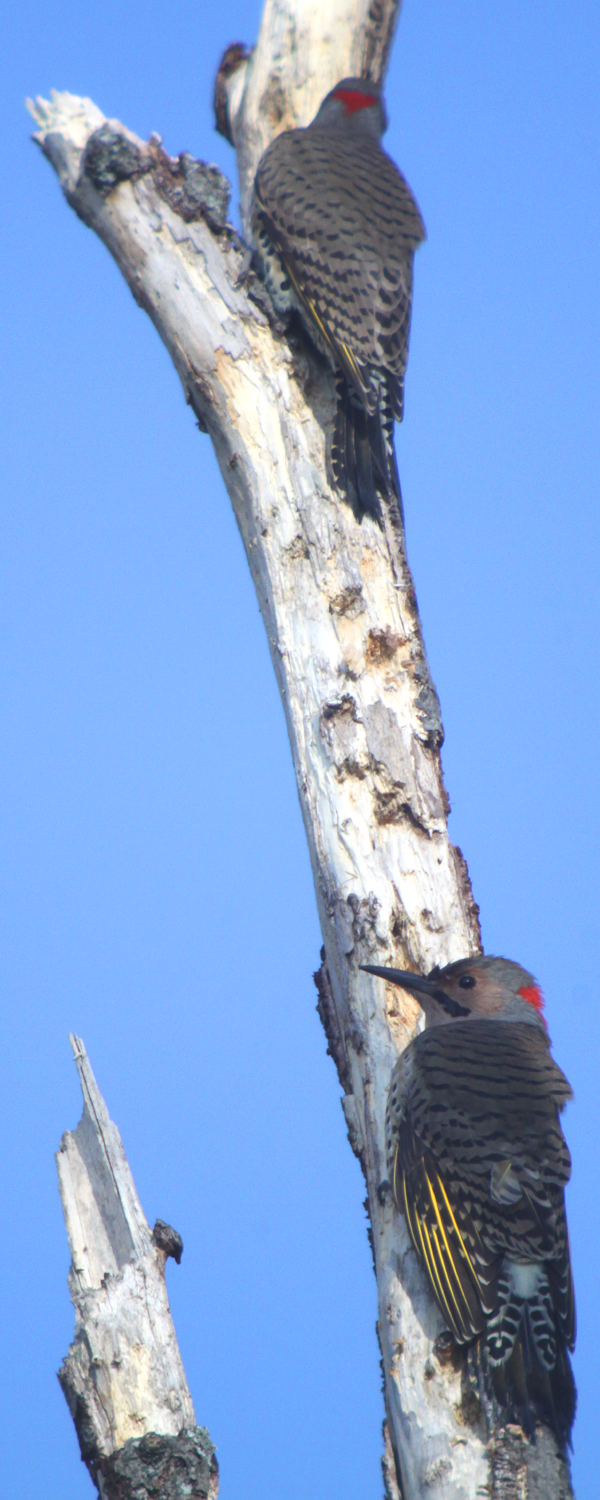
…I picked it up on the fifth ring.
‘It’s a flicker,’ I chanted into the mouthpiece.
‘What?’ a somewhat startled voice inquired.
‘It’s a flicker,’ I repeated, in my most cheerful voice.
‘There was a moment’s stunned silence, then a cautious inquiry. ‘Is this the Audubon Society?’
‘Yes ma’am,’ I replied.
‘Oh, good, maybe you can help me. There’s a strange bird sitting on our lawn that’s all brown with black spots and…’
No doubt about it. A flicker day for sure.
Dunne is, of course, referring to the Northern Flicker Colaptes auratus, or, to be more (sub) specific because he is an east coast birder, the Yellow-shafted Flicker. You see, at one time there were two flickers, one with yellow underwings and one 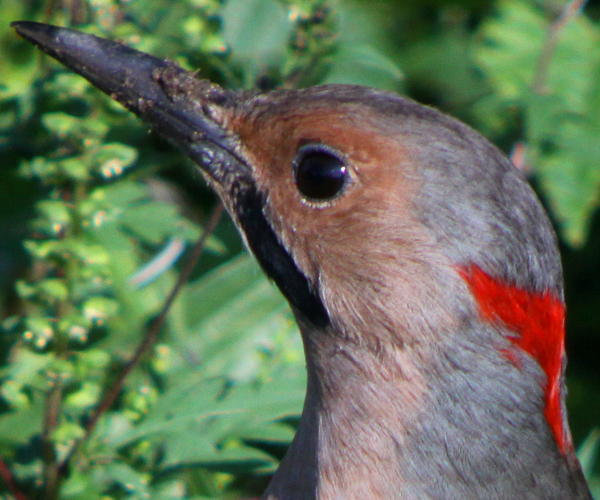 with red underwings and each was considered its own species.* Those days are gone now, as the lumpers won that skirmish back in the 1970s, and we are stuck with the less poetic, but perhaps more accurate, Northern Flicker.
with red underwings and each was considered its own species.* Those days are gone now, as the lumpers won that skirmish back in the 1970s, and we are stuck with the less poetic, but perhaps more accurate, Northern Flicker.
But, wait, what the heck is a flicker? A flicker is a woodpecker, but a bizarre kind of woodpecker. One will rarely see a Northern Flicker doing that most famous of woodpecker activities, that is, bashing its head into a tree (they do drum, as most woodpeckers do, as a replacement for song, but tend not to drill for food in trees). No, flickers are more genteel, and are prone to picnics. Seriously, they sit on lawns and eat what they find there, often turning the tables, so to speak, on ants, by eating the little insects on their flicker picnics. They have long barbed tongues that are ideal for snaking into anthills and lapping up ants.
Flickers are also odd in the woodpecker world, but not unique, in that they are migratory, and it is in the fall, when flocks of flickers sometimes show up, that befuddled homeowners start trying to find out what the heck is on their lawn. It was on a bright, sunny, fall day that I got these images at Kissena Park in Queens, NY. Flocks of flickers were foraging in the area and, for once, they allowed me a close enough approach that I could get some decent pictures. I hope you like these flicker shots as much as flickers like ants!
…
*There are other differences as well. Red-shafted Flickers have a mostly-gray face, while Yellow-shafted Flickers have a brown face. Male red-shafts sport a red malar stripe while the male yellow-shafts have a black one. Both genders of the Red-shafted Flicker lack the red crescent on the back of the head.
Apart from a bunch of great writers, we also have weekly series on


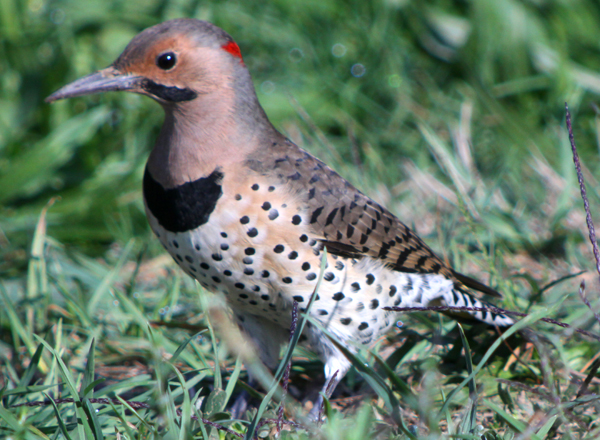

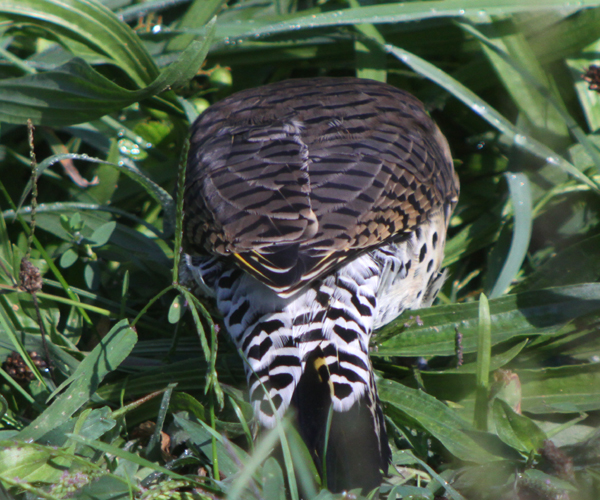
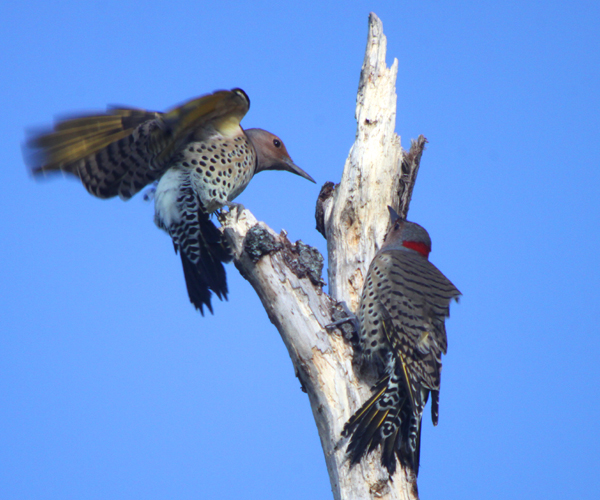
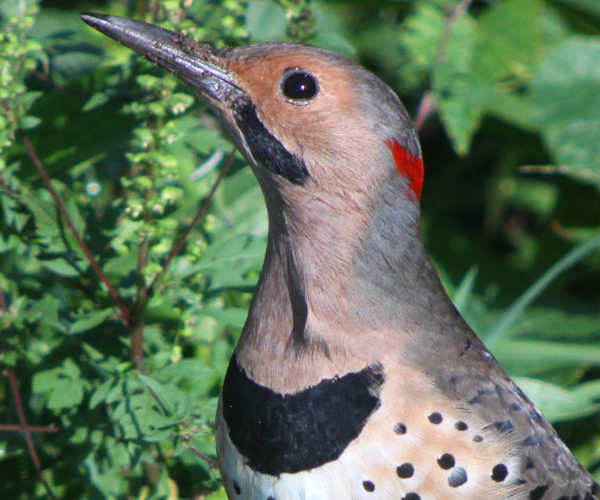






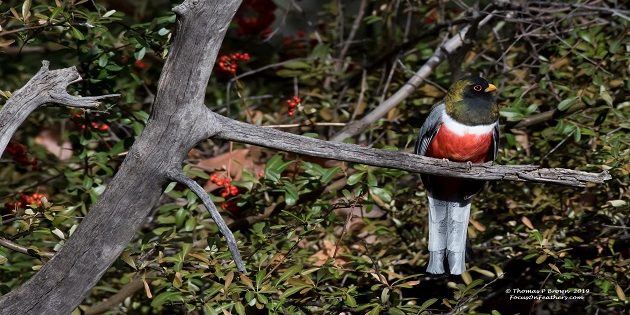




We have flickers here quite often. I’ve seen them picking out the ants from the cracks in my backyard patio. They are beautiful birds.
There were lots of Flickers on my walk in North Carolina this morning too. They must be moving all down the eastern US over the last couple days.
“Flocks of flickers…”
Yupp, clearly a Mike Bergin post. Love it!!
Crap, it was COREY who wrote this??? Wow, come on, you had Mike as a ghost writer???
Geez, messed up Monday again. Well, one of my colleagues made the coffee at the office this morning, what can I say, a clear under-dose of caffeine!
Cheers, mate!
@Jochen: At least you haven’t misidentified any clearly photographed birds recently. 🙁
Wow! A friend gave me the link to this post. Sounds so familiar! It took me a while to identify this fellow too: http://moremirthquake.blogspot.com/2010/09/stranger-by-road-northern-flicker.html
Hi, Corey – just found your web site because I was googling flickers. I’ve got 7 in my back yard right now, the most I’ve ever seen at once. We almost always have two or three in the spring, but I was surprised to see so many. Apparently they flock together in the spring as well. I’m in the Finger Lakes region, by the way. Great web site!
We have been getting the odd red wing flicker over the past few months feeding at our suet ball hanging from our tree about 10 feet from the ground. We live in south western British Columbia, Canada. Before my mom died 3 weeks ago, I told her to visit me as a red wing flicker after she died. One flicker visited our feeder the day after she died and we hadn’t seen any since. Then yesterday, I was standing at our kitchen window and said, “Come on mom. You have had time to cross over to the other side. LOL” Just then I saw a bird in the distance flying towards our home. I thought, “could this be?” And voila, a red wing flicker flew into our yard and started feeding on our suet ball. Then two more flickers appeared. Who knows? Maybe birds carry the spirit of our loved ones! ?
There were Black headed, white polka dotted breasted birds in my yard and a brownish grey headed ,white polka dotted breast. I have never seen anything like them before . Do you know what species they are ,So different then what I have seen. I truly mean white polka dots !!! It was amazing to see.
Sincerely
Patricia
Patricia, I am 99% sure that you are describing adult and young starlings.
Just experienced my first sighting of the Flicker Woodpecker here in New Bern North Carolina”) Pretty exciting,
Ronda,
I had an odd bird today. I first heard an odd noise several times while on our screened in porch. The porch is high off the ground and in the woods. I then spotted this bird I have never seen before in the tree closest to the porch. I “talked” to it and it flew toward me and landed on the ground.( My brother died 2 months and one week ago.) I had been sitting on the porch thinking about him and what he might of thought about an issue that related to him. I wanted his approval for something I had done. This bird stood there on the ground and I stood on the porch just looking at him. He was beautiful and did not act afraid of me. He went under the porch and must have stayed because I never saw him leave. I immediately felt that he was my brother and it was his way of telling me what I did was okay with him.
My husband and I have had 3 other bird incidences here in the country after our loved ones have died. All three of those birds where snow white. This bird tonight was so sweet and came to me when I spoke to it.
Just wanted to share this.
Blessings
I forgot to mention it was a flicker Yellow shafted. In Indiana.
Saw one this morning in Bethpage, NY. Had never seen one before.
i saw two birs that looked like the northern flicker but were grey with double black breasts with lots of large round white spots. my dad saw them earlier the same day and both times they were eating from our bird feeders. we live in winchester. are they adolescent northern flickers?
i have just seen the same bird today. two of them. do you think they are adolescent northern flickers?
I think you probably had starlings.
the funny thing is that we have lots of starlings and these were much bigger and had very different markings
Saw this bid today in a tree i our yard in Omaha, Nebraska. Beautiful! Never have seen one before.
I had never seen such a beautiful bird before . Its spots were in a unique pattern and the red line in the top of its head was beautiful. I took a picture but it was blurry.
I just saw one in south texas when i was hunting
I saw my first flicker today. Got good pictures and video to prove it! I called my sister and told her I had a bird that resembled a woodpecker, only it was acting like a chicken, eating off the ground. Glad I found this website. Your description is perfect – and the pictures verify my sighting. I’m in East Tennessee, really close to the Virginia state line.
So sad! We found a yellow shafted flicker hanging by his beak from a 3rd story window screen this afternoon. He must’ve flown into the window and caught his beak in the screen. A beautiful bird, polka dots on his chest, yellow edged tail feathers, a red crest on his head and a black marking at the front of his neck. He was completely stuck and it was no easy task to extract his beak from the screen.
yo i just saw one on my front lawn
I had three of these birds on my back lawn very early this am, they acted like woodpeckers but were pecking my lawn nit a tree, and wow they are beautiful I live in Bathurst New Brunswick Canada.
Today Aug 17 2015 afternoon in Greenwood Nova Scotia Canada there was a Flicker on my back lawn. I had no idea what kind of bird it was until I Googled it and found what kind it was. Are new to this area as this the first time I’ve seen a bird of this kind. The Blue Jays (birds that is) were very curious and kept an eye on it.
We have had a lone Flicker here in Chestermere Alberta since the spring. It is still here so I am wondering if it will fly South for warmer weather by itself or it may winter here? Want to make sure it has the right kind food it can eat if it stays. Thanks.
We saw our first Polka Dot Woodpecker this morning in our yard digging for ants. We live in western VA. The pictures you posted here were very helpful in identifying him. Beautiful!
Glad we could help!
We have been seeing a flicker in our yard for days trying to figure out what it was . Just noticed the red on his head and found your post. Most delightful to see this species on our farm in south Mississippi. Thanks.
Just saw one of these this morning picking bugs near a tree on the lawn . First time I’ve seen one, had to look it up. We are near Cookstown, Ontario Canada.
I saw this bird in Morgan Hill ca Never seen it before today
Thanks for the nice article. Just noticed one on my lawn this morning, NJ. It reminded me of a woodpecker in the way it was pecking the lawn. Had to look it up.
spotted my first sighting of a flicker woodpecker on our lawn today! I live in Southern Ontario, near Niagara Falls…what a beauty!
Great site. I am not a birdier but do notice different species from time to time. My wife and I noticed this bird by it’s many different colors and markings as it playfully jumped on the ground. We watched them, (there were 7) and discovered they were digging into ant hills along bare ground areas in search of their dinner.
We live in Beulah, Michigan very near Lake Michigan.
I live in northern Michigan and just saw a polka dotted woodpecker for the first time ever! Very beautiful bird with a bright red spot on the back of his head. He was just hopping around in my backyard eating whatever bugs he could find in the grass.
There is a flicker in my yard right now. I’ve seen them before but always thought they were a female red-headed woodpecker.
Thanks, Corey for the site!
Corey,
I forgot to mention I’m in South Central Minnesota.
Just saw our very first (I’m 81 and spouse is 94) Polka Dot Woodpecker grazing in our yard. Beautiful bird. Hope he comes back soon.
I live in Andover, Kansas (Just 8 miles east of Wichita, Kansas) – I saw my first ever Polka Dotted Flicker this morning (Black breast plate & polka dots on rest of breast, and red feathers on back of head) – What a beautiful bird! I had to google it to learn what species it was – I’ve never sen one before – I have several bird feeders & a suet cage hanging in my trees – I’ll be looking forward to my next sighting!
Beautiful bird. I saw one on our bird bath/feeder at the beginning of June 2023 in Conklin, NY.
I just seen one in my yard sitting on a wooden pole. What a beautiful bird. Never saw this type on bird on Long Island especially in my yard.
We live in Southern Indiana and just had one in our backyard. We have NEVER seen one before
Wonder what he is doing in the midwest?
Just spotted at least 7 or 8 in our yard today, 01/09/2025, in Tennessee, just below the KY border. I’ve never noticed them before. What a unique looking bird. Definitely a Male Red-Shafted Flicker. Isn’t this an odd time of year for them to appear?
We moved to a new house a little over a year ago in the suburbs of Baltimore, which is where I first saw and heard a flicker. We have a metal drum on top of the chimney and they love to hammer on it in the late morning – it’s so loud it sounds like there’s construction going on in the house. I hear the flickers more than I see them. I think they also have a funny call that we here when they’re in the woods behind our house – almost sounds like something you would hear in a rainforest.
Just seen my first flicker did not know what is was until I looked it up beautiful bird Brookville indiana
My husband and I just saw two flickers enjoying our yard. They are so beautiful and we enjoyed them so much.
Clinton, MS